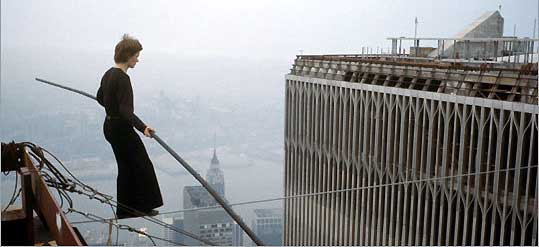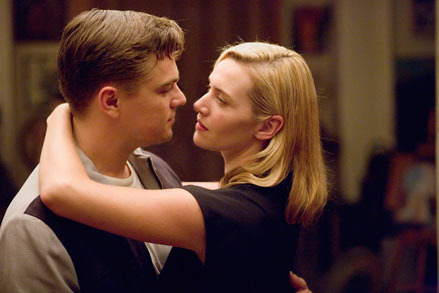
But on the nineteenth hour of the seventh day of the fifth month of 2009, (or, if you’d prefer, Stardate 62851.9), the war at long last ended. For, with the release of the eleventh film in the latter franchise, J.J. Abrams’ Star Trek, these once-feuding universes converged. Blessed with a charismatic and appealing cast that smooths over much of the choppy writing turbulence therein, Abrams’ Trek reboot isn’t only a rousing, over-the-top, sometimes patently absurd space opera that borrows as much from Lucas’ original trilogy as it does from its erstwhile source material — It’s also probably the best of the Star Wars prequels. The more I’ve thought about it over the past few days, the less sense the movie makes, and the more and more shamelessly derivative Trek seems. But darned if I didn’t have a good time during the Big Show itself, which, of course, is what really matters in the end.
This iteration of Trek begins with an on-duty starship encountering the usual deeply weird phenomena on the fringes of Federation territory — in this case, a lightning storm in space. And, just like that giveaway red shirt on an unknown Away Team member (see also: Sam Rockwell in Galaxy Quest), the fact that said ship is not emblazoned Enterprise but, rather, the U.S.S. Kelvin signifies that there’s probably some serious trouble ahead. (Also, just as Lts. Chekov and Uhura on the original bridge signifed an optimistic faith in mankind’s ability to move past the Cold War, racial inequality, and other seemingly intractable dilemmas of the Sixties, the fact that the Kelvin is captained by Pakistani-American actor Faran Tahir, most recognizable as the Mandarin-sponsored Afghan terrorist of Iron Man, indicates that the Trekverse laudably remains an hopeful and inclusive one.)
Well, the allegorical obstacles in Trek may come and go, but then as now, aliens with ridges and/or tattoos on their head are usually up to no good. And, sure enough, a disgruntled Romulan named Nero (Eric Bana) soon emerges from said lightning cloud and obliterates the Kelvin…but not before some daring, ultimately suicidal heroics by acting Captain George Kirk. Cut to several years later, when Kirk’s only son, James Tiberius, is acting out his abandonment issues by transgressing authority whenever possible amid the cornfields of Iowa. (Hey, good news, Ad Rock — the Beastie Boys still get some run in the 23rd century.) Meanwhile, over on the planet Vulcan, Spock, a young boy of mixed lineage — Vulcan father, human mother — fends off the taunts of his schoolmates and struggles more than most to keep his emotions in check. (Playing Spock’s parents are Ben Cross, looking quite a bit like the Sarek of old, Mark Lenard, and Winona Ryder, inexplicably cast to wear bad age make-up, respectively.)
Another jump forward, and James T. Kirk (Chris Pine, a real find), still raisin’ less corn and more hell than most around him, is shamed into joining Starfleet after a bar brawl by Capt. Christopher Pike (Bruce Greenwood), who just-so happened to write his dissertation(?) on Kirk the elder’s heroism. (Pike will conveniently forget much of this later on.) Meanwhile, Spock (Matthew Quinto, making the post-Sylar leap) has had it up to his eyebrows with Vulcan nativism and has subsequently enlisted in Starfleet himself, where his duties include, among other things, developing the diabolical Kobayashi Maru. These two men are clearly on a collision course: Kirk’s bold, earthy blend of action and intution — “leap before you look,” basically — is the exact opposite of Spock’s cold embrace of logic and reason. And, when Nero returns to threaten Vulcan, and, subsequently, Earth, will these two potential heroes be able to get past their obvious differences and form a winning team? Unfortunately, Leonard “Bones” McCoy (Karl Urban, doing a pitch-perfect DeForrest Kelley) has been shuffled to the background, and isn’t really around to square that circle like he once did.
There’s more to the story, of course, including a mid-act time-travel twist that, especially by Trek standards, is more elegant than most. (I particularly liked how it preserved all of the classic continuity while allowing for anything to happen in this new, pocket universe.) But the basic gist here is: Let’s get the Band Together! And, as per the “future-nostalgia” habit of so many prequels these days, Trek spends a good bit of its run just getting all of the Enterprise‘s ducks in a row — Scotty in the engine room, Bones in the medbay, Uhura (wo)manning the comm, etc. This could all get pretty tiresome in terms of inside-baseball, I guess — there are shout-outs to everything from Orion slave girls to Scott Bakula’s beagle — if the cast here wasn’t so uniformly game for anything that comes along. Kirk, Bones, Chekov, and Scotty in particular are all written a bit broadly, but the actors really succeed in selling even the goofiest subroutines here. And having the imprimatur of you-know-who of the classic era — playing Obi-Wan Kenobi basically — really lends Abrams’ Star Trek reboot a touch of class that I’m not even sure the Shat could’ve provided.
Now, speaking of Obi-Wan, I guess it’d be a bit churlish, after the depressing lowlights of Insurrection and Nemesis, to begrudge fans of this universe “A New Hope.” Still, even with glimmers of Trek’s previous highs — the surveying-the-Enterprise sequence of The Motion Picture, the humor and ship-to-ship combat of Wrath of Khan — every so often, there’s just an extraordinary amount of ganking from the Original Trilogy going on here. Now, as I said above, I’m one who thinks there’s a lot more in common between Wars and Trek than is often acknowledged. Whether it’s Luke using the Force at the last possible moment, or simply Scotty/Geordi reversing the dual positronic overlays on the tachyon inhibitors surrounding the dilithium field, we’re still in deus-ex-machina territory nine times out of ten. (And imho, Trek, despite its reputation, was never really close to being hard-sci-fi anyway.) That being said, the sweeping, larky space opera tone of Star Wars has been almost completely appropriated here by Abrams and his writing team, to the point where it almost seems actionable. (Although, now that I think about it, the SW prequels, with their flat, wooden scenes of actors discoursing interminably about the taxation of trade routes and/or New Agey questions of morality, was actually pretty close to bad Trek.)
And it’s not just the tone. Despite having some very Skywalker-ish Daddy issues, and sharing his very own “Twin Suns” moment of destiny with a constitution-class starship in Iowa drydock, James T. Kirk here is, for all intent and purposes, a swaggering, swashbuckling “scoundrel” in the mode of Han Solo. There’s a Mos Eisley-ish cantina sequence where, particularly by Trek standards, Star Wars-style aliens abound. The pre-sibling reveal, Luke-Han-Leia love triangle of ANH is grafted note-for-note onto Spock-Kirk-Uhura. There’s an ice moon strongly reminiscent of Hoth, with a Wampa-like creature and (in one of the weakest moments of the film) a Naboo-like “always a bigger fish” food chain. (On this one i’ll concede, it’s also a lot like Rura Penthe, the “aliens’ graveyard” of Star Trek VI.) They even go so far as to give Scotty an ugnaught (although, it does look a bit like Twiki, and given a later Augustus Gloop-like incident involving Montgomery Scott and a water-pipe, it could also be an Oompa-Loompa.) If imitation is the sincerest form of flattery, then it’s clear: new Trek and old-school Star Wars are very much on the same page.
Unfortunately, that page as presented here still needs one more rewrite. Thanks to the sterling cast and some spiffy camerawork (the ubiquitous lens flares do get to be a bit much, tho), I happily went along for the ride for most of Trek. But even during the funhouse itself, some glaring errors in logic become harder and harder to ignore. Now, I’m not talking about continuity lapses with what’s come before — I think the reboot here makes sense on its own terms, and that’s not my bag when it comes to Trek anyway. Nor am I really talking about science problems, even though they’re considerably worse here than usual for Trek. (Much violence is done to our understanding of black holes in this film — Schwarzchild does not exist in this dojo. Then again, it’s probably too much to ask that Trek get gravity wells right when, judging by the completely absurd freefalling-onto-the-space-drill sequence, regular ole gravity is hard enough. But, hey, once you accept warp speed, I guess all bets are off anyway.)
No, the real problems arise with basic storytelling lapses that, if you’re wired that way (and I suspect most sci-fi fans are), will nag at you even during this otherwise transporting film. [Some spoilers to follow.] Like, where was Nero over the past twenty-five years, and why didn’t he use any of that time to rethink his somewhat dubious motives for vengeance? (Wiping out the Federation wouldn’t prevent in any way his planet’s demise, which, as explained, was caused by Romulus’ star going supernova.) Even given the sudden emergency at hand, why are there absolutely no ranking officers of any consequence — Pike excepted — on board the Federation’s newly-built flagship, the USS Enterprise? If it’s a serious enough matter to send raw cadets from the Academy, wouldn’t some of Starfleet’s old hands in and around San Francisco also answer the call?
Also, if “Red Matter” — don’t ask — is as unbelievably, mind-blowingly powerful as it’s portrayed here, why did the Vulcan Science Academy even bother to create — and then send off! — a heaping Big Gulp-size quantity of it? Talk about your WMD. For that matter, particularly given what happens with this stuff late in the film, why was Nero even bothering with the big Space Drill part of his plan anyway? Seems a bit purposeless, doesn’t it? And, even allowing for the mystical, Force-like workings of Fate (as well as his dubious dispatch from the Enterprise itself), Cadet Kirk running into you-know-who in a random cave in the middle of nowhere at exactly the best possible moment was show-stoppingly ludicrous. It’s the type of thing you’d expect from poorly-thought-out fanfic, not a $100 million movie.
Now I don’t mean to get too lost in the nitpicks. I really enjoyed myself during Star Trek, and, despite its storywriting faults, it’s almost assuredly the best film in the franchise since Khan (or The Voyage Home, I guess, if you’re more into the funny-Trek. I also quite enjoyed First Contact at the time, and I always thought Undiscovered Country was underappreciated.) Check your brain at the door, and Trek is about as good a reboot as we all could’ve hoped for, and a fun, sexy, summery throwback to the space operas of yore. Hey, it’s almost definitely the best Tyler Perry film ever made, and, now that the 2.0 Trekverse is up and running, you can definitely count me in for another installment with this here crew. Particularly if — from Hell’s heart, he stabs at thee! — they actually land Javier Bardem as the Big Bad for ST XII: Khan Strikes Back. Just don’t give him a Star Destroyer, and please keep Kirk away from the carbonite.




































